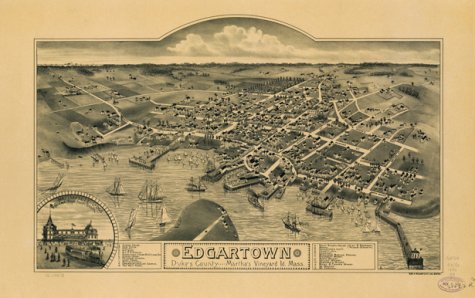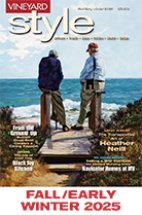COMMUNITY

Laura Jernegan: Girl on a Whale Ship
By Tom Dresser
Shortly before the close of the school year, an excited seven-year old Stella Napior told her school bus driver that her first grade class was going on a whale watch. The bus driver, with equal spark in his eyes, told her that he was reading a book about a little girl who spent three years on a whale ship. Stella asked, “Is it Laura Jernegan? We’re reading her book in school, too.” From young to old, and those in between, the story of Laura Jernegan will be told more in the 21st century than when her actual voyage began 150 years ago, thanks to the Martha’s Vineyard Museum.
Later this summer, the story behind the book about Laura, A Whaling Captain’s Daughter, will be available to anyone with access to a computer. The Martha’s Vineyard Museum has developed a website, Girl on a Whale Ship, to bring Laura’s story to life. The launch is planned for mid-August.
Education Director Nancy Cole wrote a grant proposal to the National Endowment for the Humanities, in 2005, for $10,000, to consult for an on-line exhibit about Laura’s Jernegan’s remarkable journal and her eyewitness view of 19th century whaling. “We used the funds to approach the project, determine the scope and depth of how to develop the concept,” explains Ms. Cole. They consulted experts from musician Dylan Bustin to Lisa Norling, the author of Captain Ahab Had a Wife. The museum held a weekend session to conceptualize ideas. “This grant, a consulting grant, resulted in a finite project,” says Nancy. “By the end of the weekend, we had scoped out the website project. We were now poised for planning.”
The museum received funding in the fall of 2007 from the Massachusetts Foundation for Humanities. The $5000 grant was to research, plan and define the architecture of the website. Then Nancy, now project manager turned to Digital Gizmo for help. “A museum site they designed got me excited. It’s an exemplary site and showed me what worked.” Juliet Jacobson is web designer and Don Button is programmer. Together they form Digital Gizmo, the technical team. To get underway they mocked up a prototype of Girl on a Whale Ship.
By 2008, consultants and museum staff had developed sufficient information to write a grant for implementation of the site, again to the National Endowment of Humanities. They applied through an initiative, We the People, which aims to develop, “the teaching, study, and understanding of American history, culture, and democratic principles.” Girl on a Whale Ship was a perfect fit. “It’s a huge project,” says Nancy, still amazed at the magnitude of the enterprise.
Laura’s Story
In 1868, Captain Jared Jernegan of Edgartown, set sail in the bark Roman around Cape Horn and into the Pacific to hunt for whales. Jernegan brought his wife and two young children, to ward off loneliness. Laura was six, Prescott two, when they set sail from New Bedford. Aboard ship, Mrs. Jernegan used a journal to teach Laura to write and record life on a whaleship. As the diary progressed during three years, Laura improved her writing skills, so entries were longer with deeper insight. Laura described life at sea, her brother Prescott’s antics, meeting other ships, and whaling exploits. One entry described a pre-arranged gam or meeting with her uncle in his whaler. The actual logbook of the Roman is no longer extant, so museum staff used Honolulu reports which recorded ships’ arrivals and departures, among other data, to bolster the pieces from Laura’s journal.
Captain Jernegan left his family in Honolulu to pursue whales, which migrated into the Arctic. The Roman, one of 40 whalers, most from New Bedford, chased the leviathans north. Encroaching ice trapped 33 ships. The remaining ships dumped whale oil, rescued all 1219 men and returned to Honolulu. The Roman was crushed by ice on September 7, 1871.
Mean-while, Laura, her mother and brother, had sailed to San Francisco, now a major port with the completion of the transcontinental railroad in 1869. The Jernegans took the train home, and eventually the Captain returned as well. Laura Jernegan married in 1894, moved off-Island for many years and returned after the death of her husband and settled into a house on South Summer Street. Her actual journal is preserved in the files of the Martha’s Vine-yard Museum.
Girl on a Whale Ship is not just about Laura. As Don Button, programmer, clarified, there are, “two, long format narratives: the Story of Whaling and Laura’s Story, illustrated with historic artifacts and documents.” The site also includes a timeline of whaling history. Mr. Button continues: “An interactive map shows where the whales were hunted, the typical whale ship routes, whale migration patterns and the route of Laura’s ship.” The site provides specifics about six types of whales. A visual of the interior of a whaling ship gives a sense of the confined space. Period photographs are provided. Additional information includes artifacts related to whaling, biographies of the Jernegan family, essays about whaling and a glossary of terms.
Laura’s actual journal was transcribed to digital form from her primitive cursive script. Juliet Jacobson, web designer, clarified: “it’s not really transcribing the document, it’s simply revealing a graphic of the transcription that’s been prepared ahead of time.” Under “Explore Laura’s Journal,” a magic lens enlarges script to bring the the journal to life. Visitors to the site can listen to the journal read aloud by a Vineyard seventh grader, Molly Houghton, all available at the click of a mouse. “The girl narrating is a natural,” says Juliet.
The site is data base driven. When the user navigates through the “Dive Deeper” category, the site links to information previously researched and stored in the data base. Look up Edwin Booth, the actor. (On their way home, the Jernegans saw him perform.) Zoom in on the image of a bodkin. (An arrowhead or needle to make holes in clothe.) “All the images on the site will be zoomable, and all the documents will be transcribed,” says Mr. Button. A page records the Desertion List for Bark Roman in March 1869. Job descriptions of the crew include a caricature sketch with key details, such as an anvil for the blacksmith or a broom for the cabin boy.
When asked about the challenge to design the site, Juliet was quick to bring the credit to the museum. “Nancy and her team have been working hard for many months, selecting documents and images, researching them, scanning or photographing them, writing interpretive text about them,” she says. “Don provided the museum staff with an online database manager for them to store and organize all this info. Then the website pages simply draw this info and images from the database to create the web pages dynamically.”
The museum had an abundance of data with which to work. Five cubic feet of documents and other papers are devoted to whaling and the Vineyard from 1793-1925. “The collection holds a great deal of accounts of the social world aboard a ship. The articles range from the social hierarchy aboard a ship to mutinies. Additionally, the articles touch on such issues as families aboard a ship,” says Nancy.
As the mid-August launch of approaches, there is still much to do. “We are close to panic mode,” said Nancy, an opinion confirmed by the Digital Gizmo team. Curriculum materials for teachers and pages of writing must be fine-tuned. Yet the project is virtually ready to roll.
Nancy says, “As the project manager, I have had the pleasure – and it is truly a pleasure – to be in the middle of a fantastic team of researchers, writers, web technical team, experts and colleagues at our sister repositories.” Juliet adds, “This project has really been pretty fluid and a pleasure to work on. I hate to sound like a Pollyanna, but we really haven’t had too many unforeseen obstacles.”
The immediate challenge, once the site is launched, is to get the word out. Locally, there is certain to be press coverage, but the museum would like a nationwide drive to promote the site. It’s one thing to distribute bookmarks to schools and libraries, but the team hopes for a wider audience. “Whaling as a topic resonates today,” says Nancy. “It was deadly dangerous, yet romantic and historic, an important part of our local, regional and national history. The romance and mystique of it sticks with us – is part of our collective unconscious.”
And whether past exploits or present controversy, whaling endures. The site features essays by local authors that focus on whaling issues and Laura Jernegan. The role of African Americans in whaling is a clear subtext of the site. Matt Stackpole, former director of the museum and now at Mystic Seaport, consulted on the content. Consultant Michael Dyer, librarian and maritime historian of the New Bedford Whaling Museum, worked closely with Museum staff. More than 20 people were involved in the project.
A physical exhibit of Girl on a Whale Ship opened on June 18th at the museum and runs until late autumn. Laura’s Journal – the real thing – will be also be on display.
The Girl on a Whale Ship can anticipate smooth sailing on the digital seas at www.mvmuseum.org.
Later this summer, the story behind the book about Laura, A Whaling Captain’s Daughter, will be available to anyone with access to a computer. The Martha’s Vineyard Museum has developed a website, Girl on a Whale Ship, to bring Laura’s story to life. The launch is planned for mid-August.
Education Director Nancy Cole wrote a grant proposal to the National Endowment for the Humanities, in 2005, for $10,000, to consult for an on-line exhibit about Laura’s Jernegan’s remarkable journal and her eyewitness view of 19th century whaling. “We used the funds to approach the project, determine the scope and depth of how to develop the concept,” explains Ms. Cole. They consulted experts from musician Dylan Bustin to Lisa Norling, the author of Captain Ahab Had a Wife. The museum held a weekend session to conceptualize ideas. “This grant, a consulting grant, resulted in a finite project,” says Nancy. “By the end of the weekend, we had scoped out the website project. We were now poised for planning.”
The museum received funding in the fall of 2007 from the Massachusetts Foundation for Humanities. The $5000 grant was to research, plan and define the architecture of the website. Then Nancy, now project manager turned to Digital Gizmo for help. “A museum site they designed got me excited. It’s an exemplary site and showed me what worked.” Juliet Jacobson is web designer and Don Button is programmer. Together they form Digital Gizmo, the technical team. To get underway they mocked up a prototype of Girl on a Whale Ship.
By 2008, consultants and museum staff had developed sufficient information to write a grant for implementation of the site, again to the National Endowment of Humanities. They applied through an initiative, We the People, which aims to develop, “the teaching, study, and understanding of American history, culture, and democratic principles.” Girl on a Whale Ship was a perfect fit. “It’s a huge project,” says Nancy, still amazed at the magnitude of the enterprise.
Laura’s Story
In 1868, Captain Jared Jernegan of Edgartown, set sail in the bark Roman around Cape Horn and into the Pacific to hunt for whales. Jernegan brought his wife and two young children, to ward off loneliness. Laura was six, Prescott two, when they set sail from New Bedford. Aboard ship, Mrs. Jernegan used a journal to teach Laura to write and record life on a whaleship. As the diary progressed during three years, Laura improved her writing skills, so entries were longer with deeper insight. Laura described life at sea, her brother Prescott’s antics, meeting other ships, and whaling exploits. One entry described a pre-arranged gam or meeting with her uncle in his whaler. The actual logbook of the Roman is no longer extant, so museum staff used Honolulu reports which recorded ships’ arrivals and departures, among other data, to bolster the pieces from Laura’s journal.
Captain Jernegan left his family in Honolulu to pursue whales, which migrated into the Arctic. The Roman, one of 40 whalers, most from New Bedford, chased the leviathans north. Encroaching ice trapped 33 ships. The remaining ships dumped whale oil, rescued all 1219 men and returned to Honolulu. The Roman was crushed by ice on September 7, 1871.
Mean-while, Laura, her mother and brother, had sailed to San Francisco, now a major port with the completion of the transcontinental railroad in 1869. The Jernegans took the train home, and eventually the Captain returned as well. Laura Jernegan married in 1894, moved off-Island for many years and returned after the death of her husband and settled into a house on South Summer Street. Her actual journal is preserved in the files of the Martha’s Vine-yard Museum.
Girl on a Whale Ship is not just about Laura. As Don Button, programmer, clarified, there are, “two, long format narratives: the Story of Whaling and Laura’s Story, illustrated with historic artifacts and documents.” The site also includes a timeline of whaling history. Mr. Button continues: “An interactive map shows where the whales were hunted, the typical whale ship routes, whale migration patterns and the route of Laura’s ship.” The site provides specifics about six types of whales. A visual of the interior of a whaling ship gives a sense of the confined space. Period photographs are provided. Additional information includes artifacts related to whaling, biographies of the Jernegan family, essays about whaling and a glossary of terms.
Laura’s actual journal was transcribed to digital form from her primitive cursive script. Juliet Jacobson, web designer, clarified: “it’s not really transcribing the document, it’s simply revealing a graphic of the transcription that’s been prepared ahead of time.” Under “Explore Laura’s Journal,” a magic lens enlarges script to bring the the journal to life. Visitors to the site can listen to the journal read aloud by a Vineyard seventh grader, Molly Houghton, all available at the click of a mouse. “The girl narrating is a natural,” says Juliet.
The site is data base driven. When the user navigates through the “Dive Deeper” category, the site links to information previously researched and stored in the data base. Look up Edwin Booth, the actor. (On their way home, the Jernegans saw him perform.) Zoom in on the image of a bodkin. (An arrowhead or needle to make holes in clothe.) “All the images on the site will be zoomable, and all the documents will be transcribed,” says Mr. Button. A page records the Desertion List for Bark Roman in March 1869. Job descriptions of the crew include a caricature sketch with key details, such as an anvil for the blacksmith or a broom for the cabin boy.
When asked about the challenge to design the site, Juliet was quick to bring the credit to the museum. “Nancy and her team have been working hard for many months, selecting documents and images, researching them, scanning or photographing them, writing interpretive text about them,” she says. “Don provided the museum staff with an online database manager for them to store and organize all this info. Then the website pages simply draw this info and images from the database to create the web pages dynamically.”
The museum had an abundance of data with which to work. Five cubic feet of documents and other papers are devoted to whaling and the Vineyard from 1793-1925. “The collection holds a great deal of accounts of the social world aboard a ship. The articles range from the social hierarchy aboard a ship to mutinies. Additionally, the articles touch on such issues as families aboard a ship,” says Nancy.
As the mid-August launch of approaches, there is still much to do. “We are close to panic mode,” said Nancy, an opinion confirmed by the Digital Gizmo team. Curriculum materials for teachers and pages of writing must be fine-tuned. Yet the project is virtually ready to roll.
Nancy says, “As the project manager, I have had the pleasure – and it is truly a pleasure – to be in the middle of a fantastic team of researchers, writers, web technical team, experts and colleagues at our sister repositories.” Juliet adds, “This project has really been pretty fluid and a pleasure to work on. I hate to sound like a Pollyanna, but we really haven’t had too many unforeseen obstacles.”
The immediate challenge, once the site is launched, is to get the word out. Locally, there is certain to be press coverage, but the museum would like a nationwide drive to promote the site. It’s one thing to distribute bookmarks to schools and libraries, but the team hopes for a wider audience. “Whaling as a topic resonates today,” says Nancy. “It was deadly dangerous, yet romantic and historic, an important part of our local, regional and national history. The romance and mystique of it sticks with us – is part of our collective unconscious.”
And whether past exploits or present controversy, whaling endures. The site features essays by local authors that focus on whaling issues and Laura Jernegan. The role of African Americans in whaling is a clear subtext of the site. Matt Stackpole, former director of the museum and now at Mystic Seaport, consulted on the content. Consultant Michael Dyer, librarian and maritime historian of the New Bedford Whaling Museum, worked closely with Museum staff. More than 20 people were involved in the project.
A physical exhibit of Girl on a Whale Ship opened on June 18th at the museum and runs until late autumn. Laura’s Journal – the real thing – will be also be on display.
The Girl on a Whale Ship can anticipate smooth sailing on the digital seas at www.mvmuseum.org.








